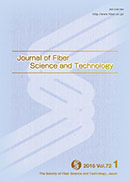All issues

Volume 79, Issue 12
Displaying 1-1 of 1 articles from this issue
- |<
- <
- 1
- >
- >|
Transaction
-
Minoru Aoyagi, Naoki Fukuda, Takahiro UenoArticle type: Transaction
2023 Volume 79 Issue 12 Pages 288-296
Published: 2023
Released on J-STAGE: December 12, 2023
JOURNAL FREE ACCESSCalcium alginate hydrogels are used in numerous applications, such as tissue engineering and food processing. Calcium alginate hydrogels are thought to have an egg-box structure, and several studies were conducted to verify this model. In the authors’ previous study, fluorescence microscopy was used to investigate calcium alginate hydrogels prepared using sodium alginate, calcium sulfate dihydrate, trisodium phosphate 12-hydrate, glycerol, and purified water for ultrasound phantoms. The study indicated the presence of fibers in calcium alginate hydrogels. Because these fibers could not be extracted from the hydrogel, they could not be further analyzed. In this study, these fibers were extracted from calcium alginate hydrogels by staining them with a calcein solution that is a calcium indicator. The extracted fibers were then observed using fluorescence microscopy, scanning electron microscopy, and scanning transmission electron microscopy. The fluorescence microscopy and scanning electron microscopy results revealed that the fibers exhibited bamboo-like structures containing cavities and bamboo joints. The scanning transmission electron microscopy results indicated that the building blocks of the bamboo-like structures were likely molecule-sized structures. Each of the micrometer-sized bamboo-like structures and molecule-sized structures formed a network. Thus, the water incorporated in the calcium alginate hydrogels was likely retained by these hierarchical networks. Therefore, the extraction method of the fibers and their bamboo-like and molecular-sized structures were visually demonstrated in this study.View full abstractDownload PDF (3519K)
- |<
- <
- 1
- >
- >|